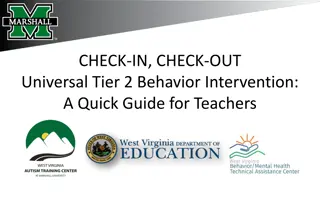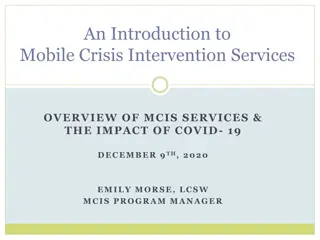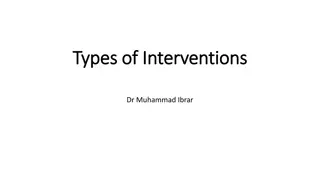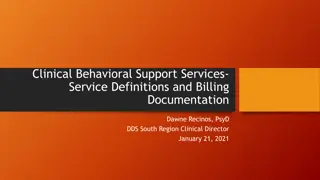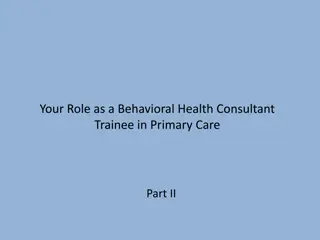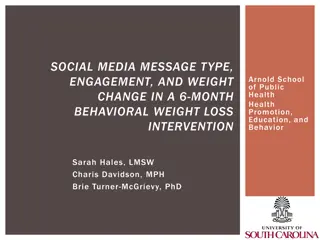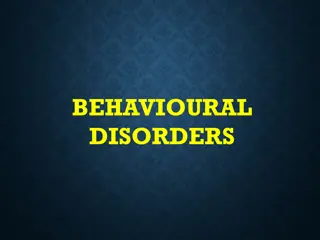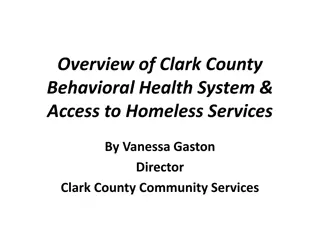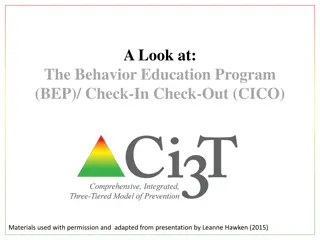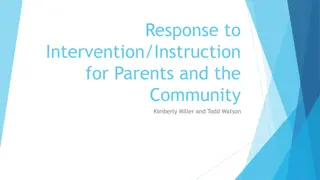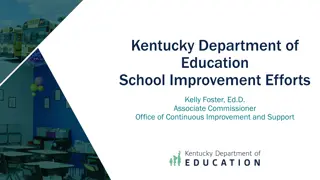Comprehensive Overview of Check-In/Check-Out Intervention for Behavioral Support in Schools
The content provides detailed information on the Check-In/Check-Out (CICO) intervention for behavioral support in schools. It covers the implementation levels, benefits, research support, intervention overview, reasons why CICO works, and the basic cycle involved in CICO. The CICO strategy aims to enhance social competence, academic achievement, and support student behavior through systematic performance feedback and adult attention. It is effective for at-risk students and can decrease problem behaviors when implemented correctly.
Download Presentation

Please find below an Image/Link to download the presentation.
The content on the website is provided AS IS for your information and personal use only. It may not be sold, licensed, or shared on other websites without obtaining consent from the author.If you encounter any issues during the download, it is possible that the publisher has removed the file from their server.
You are allowed to download the files provided on this website for personal or commercial use, subject to the condition that they are used lawfully. All files are the property of their respective owners.
The content on the website is provided AS IS for your information and personal use only. It may not be sold, licensed, or shared on other websites without obtaining consent from the author.
E N D
Presentation Transcript
Checking in on Check In/Check Out DEBORA LINTNER MO SW-PBS TIER 2/3 CONSULTANT SUSAN LONG ASSISTANT PRINCIPAL SIKESTON 5-6 GRADE CENTER
Social Competence & Social Competence & Academic Achievement Academic Achievement OUTCOMES Supporting Data Decision Making Supporting Staff Behavior PRACTICES Supporting Student Behavior
Three Levels of Implementation A Continuum of Support for All Academic Systems Behavioral Systems Tier Three Individual Students Assessment-based High Intensity Tier Three Individual Students Assessment-based Intense, durable procedures Tier Two Some students (at-risk) High efficiency Rapid response Tier Two Some students (at-risk) High efficiency Rapid response Tier One All students Preventive, proactive Tier One All settings, all students Preventive, proactive
What is the benefit CICO? Research supported practice Schools can successfully implement Decreases problem behavior Effective for 60-75% of second tier, at-risk students Less effective for students who do not find adult attention reinforcing Use of Functional Behavior Assessment can enhance success (Crone, Horner, & Hawken, 2004, pp. 9-10)
Intervention Overview Small group intervention to provide Daily organization and behavioral support Systematic performance feedback High rates of adult attention Mechanism for making data-based decisions Communication link between school and home
Why does CICO Work? Improved structure Student is set up for success Increase in specific feedback -
Why Does CICO Work? Program can be applied in all school locations Links school support and home Organized to fade into a self-management system
Check-In/Check-Out Basic Cycle 1. Morning check-in (Get Daily Progress Report) 2. Regular teacher feedback throughout day 3. End of day check-out Tally and record points Receive recognition 4. Data collection & progress monitoring 5. Take DPR home & return signed copy
Student Recommended for CICO CICO Implemented CICO Coordinator Summarizes Data For Decision Making Morning Check-in Parent Feedback Regular Teacher Feedback Bi-weekly CICO Meeting to Assess Student Progress Afternoon Check-out Revise Program Exit Program
Implementation Example Morning Check-in Consistent location Begin with positive greeting Prompt for picking up daily progress report (DPR) Prepare for day (breakfast, pencil, paper, planner) Reminder of expectations Provides access to positive adult attention, precorrect for behavioral and academic expectations and organizes student materials
Implementation Example Throughout the Day Student carries a daily progress report (DPR) Teacher greets and pre-corrects Established criteria for pre-corrects and points Teacher provides feedback and awards points Provides high rates of adult attention and specific performance feedback
Implementation Example End of Day Check-out Consistent Location Adult positive greeting Total points, calculate percentage, and enter data Daily and/or weekly reinforcement for meeting goals Quick debrief with student Provide parent communication Provides positive adult attention, specific performance feedback and progress monitoring.
Who Benefits? CICO is for students who: Continue to display problems after PBS Universal/Tier 1 supports in place Demonstrate behavior patterns that are functionally related to obtaining attention Need increased levels of structure, routine and feedback 121
Who Benefits? Students in the 2-5 office referral range Low level disruptions -Talk out -Unprepared -Talk back -Non-compliant Data indicating attention maintained behavior Student willingness to participate *Students with more intense problems may benefit, but will need additional supports!
Crone, D. A., Hawken, L. S. & Horner, R. H. (2010). Responding to Problem Behavior in Schools: The Behavior Education Program. New York: Guilford Press.
Resources Needed CICO Coordinator Approximately 1 hour per week maintenance CICO Facilitator Approximately 1 hour per week maintenance CICO Facilitator Approximately 1 hour per week maintenance Student 123 Student Student Student Student Student Student Student Student Student
Steps to Implementation Steps to Implementation 1. Consider program design for your school 2. Develop a daily progress report (DPR) 3. Design a reinforcement system 4. Select a system for managing daily data 5. Establish plans for fading 6. Create staff training materials and time 7. Provide information for students and parents
Who We Are 532 fabulous students 58% FRL 10% SPED 0 ELL 2% Homeless
1. Program Design Team Student Identification Teacher nomination Data Collection-ODRs Family Notification/Permission Introducing the Program Teachers Family Students
3. Reinforcement System The primary reinforcer is personal connection with CICO adult. -Checking in -Checking out -Meeting daily and/or weekly point goal Students who participate in the CICO Intervention still participate in the schoolwide system of encouraging appropriate behavior and discouraging inappropriate behavior.
4. Data Management Team process for monitoring progress and making decisions -Regularly scheduled meetings -Standard meeting format -Team roles Easy access to additional information -Attendance, Grades, ODR, Minors Informed choices/Evaluate based on goal -Continue or Fade; Modify or Intensify
Data Management What Data? Collection of Data What to do with the data? Poor Response Questionable Response Positive Response Are we implementing with fidelity? With whom is the data shared? TEAM
5. Plans for Fading Train student for self-management Celebration of graduation from the program Support for student after the program ends
6. Staff Training Who should be trained? Teachers Facilitators When should training occur? Initial training should include: What CICO is. What CICO is not.
7. Student/Parent Training Get parents and students excited about this opportunity CICO is an intervention to work towards self monitoring It s not a life sentence for student
Contact Information Susan Long, Assistant Principal Sikeston 5th 6th grade center slong@Sikeston.k12..mo.us Debora Lintner, Tier 2/3 Consultant University of Missouri lintnerdr@Missouri.edu





